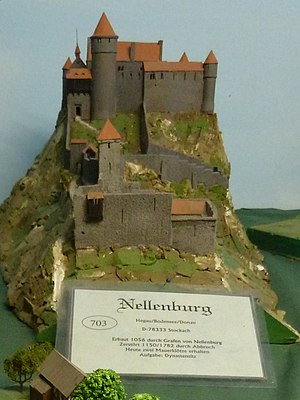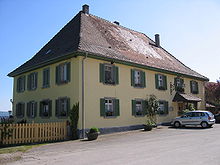Nellenburg
| Nellenburg | ||
|---|---|---|
|
Reconstruction in the Freiburg Zinnfigurenklause |
||
| Alternative name (s): | castellum Nellenburc | |
| Creation time : | around 950 | |
| Castle type : | Höhenburg, spur location | |
| Conservation status: | ruin | |
| Standing position : | Count | |
| Place: | Stockach | |
| Geographical location | 47 ° 50 '55 " N , 8 ° 59' 5" E | |
| Height: | 613 m above sea level NHN | |
|
|
||
The Nellenburg is an early medieval castle ruin west of Stockach in the Baden-Württemberg district of Konstanz in Germany .
It formed the center of power in the Landgraviate of Nellenburg .
Geographical location
The ruins of the former Spornburg ( 613 m above sea level ) are located around two kilometers west of the old town of Stockach on a Molasses spur , not far from the Nellenburger Berg ( 624 m above sea level ). This is Stockach's local mountain, which was strategically located at the western end of Lake Constance in the Middle Ages and today borders a nature reserve .
Almost 300 meters east of the castle ruins is the “young Nellenburg” with the “Nellenburg” mountain inn, but also in an exposed location. The "four-country panorama" results from a very clear view, with a view of Lake Constance and Hegau , the Austrian , Swiss and even the French Alps .
history
The Nellenburg had been the seat of the Counts of Nellenburg since the middle of the 10th century and was first mentioned in 1056 as "castellum meum Eberhardi comitis Nellenburc". However, in 958 a godfridus de Nellenburg is attested, that is, the castle already existed in the 10th century. The time it was founded is still unknown, as is its building history.
Their owner, Eberhard Graf von Nellenburg (* 1010 at Nellenburg Castle, † January 25, 1078 in Schaffhausen ), a relative of the Emperors Konrad II and Heinrich III. , founded the Benedictine monastery of All Saints in Schaffhausen in 1049 , in which the monitoring of the "lower landscape" Landgraviate Nellenburg was based on the three castles on the Hohenstoffeln , the Hohenstoffeln ruins .
Around 1050, the Nellenburgers moved the main focus of power from Zürichgau to the Upper Rhine in order to protect their newly created centers, the Allerheiligen Monastery in Schaffhausen and Nellenburg Castle.
As a result of the investiture controversy, Count Burkard († 1105), the last of the older line of Nellenburg, lost the castle, which passed to his nephew Count Dietrich in 1105; Parts of the land went to Count Adalbert von Mörsberg. The von Bürgeln form the so-called middle line of Nellenburg.
In 1170, the County of Nellenburg was married to the Counts of Veringen , who, after dividing an inheritance from 1216 to 1422, founded the younger line of Nellenburg.
In 1291 Duke Albrecht of Austria besieged the Nellenburg, at that time the seat of Count Mangold II of Nellenburg (-Veringen), who had taken part in the uprising of Swabian nobles against Habsburg. The round main tower collapsed at that time due to undermining .
In 1422 the Nellenburg also passed into the possession of its heirs, the Lords of Tengen , who from then on became known as the Counts of Tengen. They sold the Landgraviate of Nellenburg in 1465 for 37,905 guilders to Archduke Sigismund of Austria ( Habsburg ).
Stockach was the main town of the Landgraviate of Nellenburg until the middle of the 15th century and then passed into Habsburg ownership. For 340 years, from 1465 to 1805, Stockach and the county of Nellenburg belonged to Upper Austria .
In 1499 Stockach was besieged by the Confederates , whereby the chronicle mentions that the Swiss camp was shelled by the occupation of the Nellenburg and their guns.
As building bills and files show, the castle was in poor condition in the 16th century . In 1565 it is said that the castle was "badly pawed and even made into a royal residence". In 1571, a large stretch of the wall collapsed, and not all rooms of the castle were habitable.
Either in 1639 or 1642, at the time of the Thirty Years' War (1618–1648), the Nellenburg was "badly spoiled and ruined" by the troops of the Württemberg commander of the Hohentwiel , Konrad Widerholt , so that buildings were in "Mörkhlichen" decline. The well was spilled to make the castle unusable for defense.
Some of the castle's buildings had been rebuilt by 1668/69. A land register in the Stockach City Archives reports that there were now seven rooms, nine chambers, two kitchens with ovens, three cellars and a vault. In addition, the castle chapel St. Gangolf and farm buildings existed in the outer bailey. The well had meanwhile been cleared.
In 1669 residential buildings outside the Nellenburg were mentioned for the first time, the so-called "young Nellenburg" was created. From the end of the 17th century it served as a residential building for the property managers and chief hunters of the Nellenburg.
In 1760, a description of the Landgraviate of Nellenburg states: "Nunmehro, however, the castle is in a state of disrepair because it is old and no longer wants to be paid for reparation costs, it is very ruinous and in a state of disrepair".
After the decision of the responsible upper office with administrative headquarters in Stockach to demolish the dilapidated castle including the “chapel located there”, this mostly happened in 1782/83. Stones from the castle were used to build roads and bridges in the region.
The castle, which had been severely reduced by the demolitions and a fire in the 1830s, was inhabited in the 1840s by “anemic people” who had their houses in the ruins.
In 1886 the Stockach Beautification Association built a wooden observation tower in the ruins of the main castle. In 1922 it was demolished because it was in disrepair.
From 1926 until the end of 2010 there was a restaurant in the former manor house. In the middle of the 19th century it came into the possession of the Counts of Langenstein , the noble family from the vicinity of Orsingen .
At the beginning of 2007, Axel Graf Douglas from Langenstein became the new owner. He planned to have the old shed next to the house demolished. Soon afterwards, however, Patrick Graf Douglas acquired the Nellenburg for his sons Benedikt Graf Douglas and Christopher Graf Douglas. He intends to build two more houses on the hilltop of the Nellenburg. There is a fundamental need for renovation of the existing buildings on the Nellenburg.
description
Nellenburg
From the former Nellenburg only remains of the main tower, the valley-side front wall and the remains of the wall to the forecourt have survived. The ruin is freely accessible.
Young Nellenburg
The young Nellenburg is a historically significant estate. The center of the house built in the 19th century is the dining room, which is characterized by dark wooden beams on the ceiling and wooden corner benches as well as the central tiled stove. At that time, however, the kitchen and dining room were reversed. The apartments are located above the dining room.
Say of the beautiful Nella
When Christianity began to spread by the lake, it happened that Count Mangold got lost while hunting in the thicket of the forest. After a long time he saw a small glow of fire and saw a crowd of men sitting there, dreamily listening to the harp of a maiden.
It was the pagan sacrificial place of the beautiful Nella. With holy zeal he smashed the sacrificial stone, but was captured and thrown into dungeon. Sentenced to death, the beautiful Nella took a liking to him and had him pardoned. He then asked for Nella's hand and succeeded in converting her to the Christian faith. When she asked for the baptism, a noisy fountain rose from the floor, which subsequent generations named Nellabach. Mangold built a castle at this point, which was named Nellaburg in honor of his wife.
coat of arms

The coat of arms of the old Nellenburgers is not known in a document. It probably consisted in the image of a ram and is based on that of Eberhard VI. Allerheiligen Monastery (Switzerland) Schaffhausen, which was donated by Nellenburg in 1049, and the city and canton of Schaffhausen that was later created in the process.
In 1216, Count Mangold von Veringen founded the 3rd line of the Nellenburg family by marrying the Nellenburg heir and took over their name. Since then, the people of Nellenburg have been carrying three blue deer sticks on a gold shield one above the other . For more information on the coat of arms, see → Coat of arms of the Counts of Veringen .
literature
- Arthur Hauptmann: Castles then and now - castles and castle ruins in southern Baden and neighboring areas . Südkurier Verlag, Konstanz 1984, ISBN 3-87799-040-1 , pp. 74-77.
- Michael Losse, Hans Noll: Castles, palaces, fortresses in Hegau: fortifications and noble residences in the western Lake Constance area . In: Michael Greuter (Ed.): Hegau Library 109 . Association for the history of the Hegau. Michael Greuter Verlag, Hilzingen 2006, ISBN 3-9806273-2-2 , pp. 136-137.
Web links
- Documentation of the city of Stockach
- Website of the Nellenburg
- Martin Leonhard: Nellenburg, from. In: Historical Lexicon of Switzerland .
Individual evidence
- ↑ See Moritz Oehl
- ^ Matthias Biehler: Nellenburg in the view of the councils . In: Südkurier. Stockach, July 11, 2007
- ↑ Matthias Biehler: Recognizing opportunities . In: Südkurier. Stockach, July 11, 2007
- ↑ See Moritz Oehl
- ↑ cf. Karl Alois Fickler : Sources and research on the history of Swabia and Eastern Switzerland, Schneider Mannheim 1859
- ↑ http://www.nellenburg.de/?page_id=4







